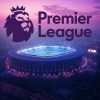Liverpool isn’t just known for Liverpool FC, as most may think. Another Liverpool-based English professional football team that participates in the Premier League, the top division of English football, at the moment is Everton Football Club.
The club joined the Football League as a founding member in 1888 and has played at the top level for a record 118 seasons, missing only four between 1930 and 1954 Everton is now ranked third in all-time point rankings and is the second-longest-running club in English top-flight football. Nine Charity Shields, five FA Cups, one European Cup Winners’ Cup, and nine league championships have been been won by the club.
Everton, which was founded in 1878, went on to win its first League Championship from 1890 to 1991 Everton experienced a period of consistent success in the middle of the 1980s, winning two further League cups, one FA Cup, and won the 1985 European Cup. The 1995 FA Cup was the club’s most recent major championship.
The nicknames “The Toffees”, “Evertonians” or “Blues” are used to refer to the club’s supporters. Liverpool is Everton’s greatest opponent; the two teams play in the Merseyside derby at Anfield, which is less than a mile from Goodison Park, which Everton calls home. Since 1892, Everton’s premises have been Goodison Park, after leaving its former home at Anfield following a dispute over rent. The team wears royal blue jerseys with white shorts and socks as their home uniform.
History and Background
Early years of the Blues
Everton’s origins go way back to 1878, when it was created under the name of St. Domingo’s FC, intending to allow the church members of St. Domingo Methodist Chapel to participate in year-round sports, mainly cricket. This is similar to the beginnings of other big clubs in the Premiership today. The team became one of the first members of the Football League in 1888–1889, and in the 1890–1891 campaign, it captured its first League Championship crown. Everton won the League Championship once more in 1914–15 after winning its first FA Cup in 1906.
Due to conflict within the club, Everton was relegated to the Second Division in 1929 The team quickly bounced back, winning promotion on the first try, and setting a Second Division scoring record. Everton quickly established itself upon returning to the top division in 1931–1932, winning the League Championship for the fourth time. In 1933, the Blues also won their second FA Cup, defeating rivals Man City in a 3-0 battle.
Everton was bumped down for the second time in 1950–51, and it wasn’t until 1953–54, when it finished second in its third run in the Second Division, that the club was promoted. Since then, the Blues have been a permanent fixture in the top division.
The 80s under Howard Kendall and the many tries for adequate results
Howard Kendall was assigned player-manager at Everton in May 1981 He led Everton through its most prosperous period ever. Everton achieved domestic success in 1984 by winning the FA Cup and two League Championships in 1984–1985 and 1986–1987. By winning the European Cup Winners’ Cup in 1985, the club captured its first and sole European trophy to date. He created a nearly entirely new team during his first tenure at Goodison Park, and it quickly established itself as one of the best of the decade. As a result of the English clubs’ exclusion from Europe following the Heysel Stadium tragedy, Kendall left Everton in the summer of 1987 and went on to manage Athletic Bilbao in Spain.
On November 7, 1990, he went back to manage Everton for a second time. Everton was fighting to avoid being demoted to the Second Division at this point, but he helped them turn things around, and they finished ninth and advanced to the FA Cup quarterfinals. Having a mediocre position in the table league, and finishing in the middle in 1992 and 1993, Kendall finally left on December 4, 1993, following a disagreement with the board of directors and poor results in the league.
In 1997, Howard Kendall was given the third managerial position at Everton, although the move was a failure once again, as the club finished seventeenth in the standings. The team’s superior goal differential against Bolton Wanderers was the only thing keeping them from being relegated.
The 2000-20s: Rooney, record transfers, Carlo Ancelotti and Moyes’ replacements
Before being sold to Manchester United for an Everton record sum of £28 million in the summer of 2004, Wayne Rooney established himself in the starting lineup of the Blues. Everton was guaranteed a spot in the UEFA Champions League qualification round thanks to a fourth-place result in the 2004–05 season. The team was out of the UEFA Cup after failing to advance through the Champions League group stage. Everton finished as the runner-up in the 2009 FA Cup Final and qualified for the 2007-08 and 2008-09 UEFA Cup campaigns.
When manager David Moyes acquired James Beattie for £6 million in January 2005, Andy Johnson for £8.6 million in the summer of 2006, Yakubu for £11.25 million in the summer of 2007, and Marouane Fellaini for £15 million in September 2008, he smashed the club record for the biggest transfer fee ever spent.
Roberto Martnez replaced manager Moyes after the conclusion of the 2012–13 campaign, and in his first season, Martnez guided Everton to 5th place in the Premier League while compiling the team’s best point total in 27 years with 72
The next year, Martnez managed to level up Everton to the UEFA Europa League round of 16 and an 11th-place Premier League finish at home. In the 2015–16 season, Everton advanced to the League Cup and FA Cup semifinals but lost both times. Following the season’s not-so-great performance, Martnez was fired by Everton, which was in 12th position.
Everton’s 2017–18 season got off to a bad start, placing them in the relegation zone after nine league matches. Martinez’s successor, Ronald Koeman, was fired in October 2017 after a 5-2 loss to Arsenal at home and was soon after overtaken by Sam Allardyce, who resigned at the end of the season due to disapproval from the Blues’ fans.
Portuguese manager Marco Silva made his way over to Liverpool to be appointed as the club’s new manager in May 2018 He led the Blues to finish eighth in his first season in charge, but on December 5th 2019, he was given the sack, after a bad start to the following season put the team once again on the verge of relegation with a shocking 14 points.
One of the “greatest managers of all time” Carlo Ancelotti was hired as Everton’s manager on December 21 2019, under a four-and-a-half-year deal. As Everton finished in twelfth position, Ancelotti went on to gather a total of eight victories, five draws, and six defeats in the league during his debut campaign with the Blues.
After Everton began the 2020–21 campaign with seven straight victories across all competitions, Ancelotti was voted the “Premier League Manager of the Month” for September 2020.
Everton finished 2020 in fourth position but was eliminated from the EFL Cup after losing 2-0 to Manchester United in the quarterfinal. Everton concluded the season in 10th place despite varied results for the rest of the season. Rafael Benitez and Frank Lampard were also managers of the Blues for a short while before both being dismissed for “extremely disappointing results”.
Records, statistics and achievements
With 751 first-team games played for the Blues between 1981 and 1997, Neville Southall is the record holder for most appearances. In second place with 534 games is the late centre-back and former captain of the Blues Brian Labone. Ted Sagar, a goalkeeper, played for 23 years for the club between 1929 and 1953, making him the club’s longest-serving goalkeeper. Dixie Dean leads the team in scoring with 383 goals in all league games, and Graeme Sharp is second with 159 Dean continues to maintain the record for the most goals scored in a season in England with 60.
Player Romelu Lukaku was sold to Manchester United for the shocking sum of £75 million, the most amount Everton has ever received for a player. The club’s record transfer signing was paid to Swansea City for the Icelandic midfielder Gylfi Sigurdsson in 2017 for the sum of £45 million.
Everton has played in 119 of the 123 seasons in England’s top division. It is one of just six teams who have participated in every Premier League season from the league’s start in August 1992 The Blues have faced Aston Villa 196 times in league games in their history, making them the team that they have faced most frequently. The Liverpool derby on September 18, 1948, had the highest home attendance ever with 78,299 spectators.
Rivalries, colours & supporters
The majority of Everton supporters are not just Liverpool-based, but travel from North Wales, Ireland, and Scotland, as well as regions of England close to the Merseyside such as Cheshire, West Lancashire, and portions of Western Greater Manchester. Although both Premier League teams Liverpool and Everton are based in the same city, the support for both is dispersed throughout the city and is not location-based.
In away games, the Toffees frequently sell out the whole fan section, and tickets sell especially well for away games in the northwestern region of England. Both sets of fans can usually be seen standing side by side in red and blue at both Anfield and Goodison Park, so it’s considered “a friendly derby”, unlike, for example, London derbies. The Liverpool derby is typically a sold-out event, however, matches in recent years have seen a tendency to be particularly tense affairs on the pitch between the players of both teams, and the games have seen the highest number of red cards for players of both teams of any game in Premier League history.
The standard home uniform for Everton consists of royal blue shirts, white shorts, and white socks. Numerous versions were worn in the 1970s-80s. Away shirts in white, yellow, grey and black have also been worn.
Team Players
Current Everton squad
Goalkeepers: Jordan Pickford, Asmir Begović, Andy Lonergan
Defenders: James Tarkowski, Nathan Patterson, Mason Holgate, Michael Keane, Yerry Mina, Vitaliy Mykolenko, Ben Godfrey, Seamus Coleman, Ruben Vinagre, Conor Coady
Midfielders: Amadou Onana, Abdoulaye Doucouré, Alex Iwobi, Tom Davies, Idrissa Gueye, James Garner
Forwards: Dwight McNeil, Dominic Calvert-Lewin, Demarai Gray, Andros Townsend, Neal Maupay, Ellis Simms
Goodison Park – the Blues’ home
Everton originally called Anfield stadium its’ home. Since 1892, the club has played at Goodison Park. More Premier League football matches have been played at Goodison Park than any other stadium in the UK, and it was the only English stadium to host a semi-final during the 1966 FIFA World Cup. A new stadium plan with 60,000 seats was proposed in 2000, but unfortunately, Everton was unable to raise the £30 million 50% sum required, and in 2003 Liverpool council, therefore, rejected the plan.
For the upcoming 2024–25 season, a completely renovated Goodison Park stadium is scheduled to debut at an estimated construction cost of £760 million.
What does the future hold for the Blue Merseysiders?
Everton may have what it takes to potentially escape the drop zone if a miracle happens. However, the blue Merseyside team is currently having a troubling period after being destroyed 4-0 by Arsenal and 2-0 by Aston Villa in the space of a week. Surely, for the team and manager Sean Dyche there are plenty of sleepless nights knowing that they are currently 18th in the Premier League standings.
Everton’s failure to counterattack quickly has been apparent in past games this season, but the team’s dominant playing style is one area where Dyche has made significant improvements. Despite having 34 points and their most recent victory being against Leeds United by a score of 1-0, things aren’t looking good for Chelsea right now.
In the last 11 head-to-head matches, Chelsea has won four, Everton has won three, and there have been four ties. In light of everything, fans should continue to believe that Everton should manage to win soon.
FAQ’s
For what is Everton best known?
Nine League Championships, five FA Cups, one European Cup Winners’ Cup, and nine Charity Shields have all been won by the club. Everton, founded in 1878, won their first League Championship in the 1890–91 campaign.
What does Everton’s name mean?
The Everton Toffee was first made in Old Ma Bushell’s sweet shop, “Ye Ancient Everton Toffee House,” which is where the team’s nickname came from. Fans bought a lot of these treats to enjoy while watching Everton play in its three former stadiums, Stanley Park, Priory Road, and eventually Anfield.
Are Everton or Liverpool more ancient?
The club’s new name – Everton, was invented in 1879 Everton was founded in 1878, a year earlier than their rivals Liverpool. St. Domingo’s FC began as a church club team in 1878, competing at Stanley Park.
Who led Everton in goals scored?
The club’s top scorers of all time are Dean Dixie, scoring an amazing 383, Graeme Sharp scoring 159, Bob Latchford with 138 goals scored, Sandy Young with 125 and 119 scored by Joe Royle.
Does Liverpool have more Irish supporters than Everton?
Since the division’s inception in 1992, Everton has given more Premier League weekends away to Irish players than Liverpool.







